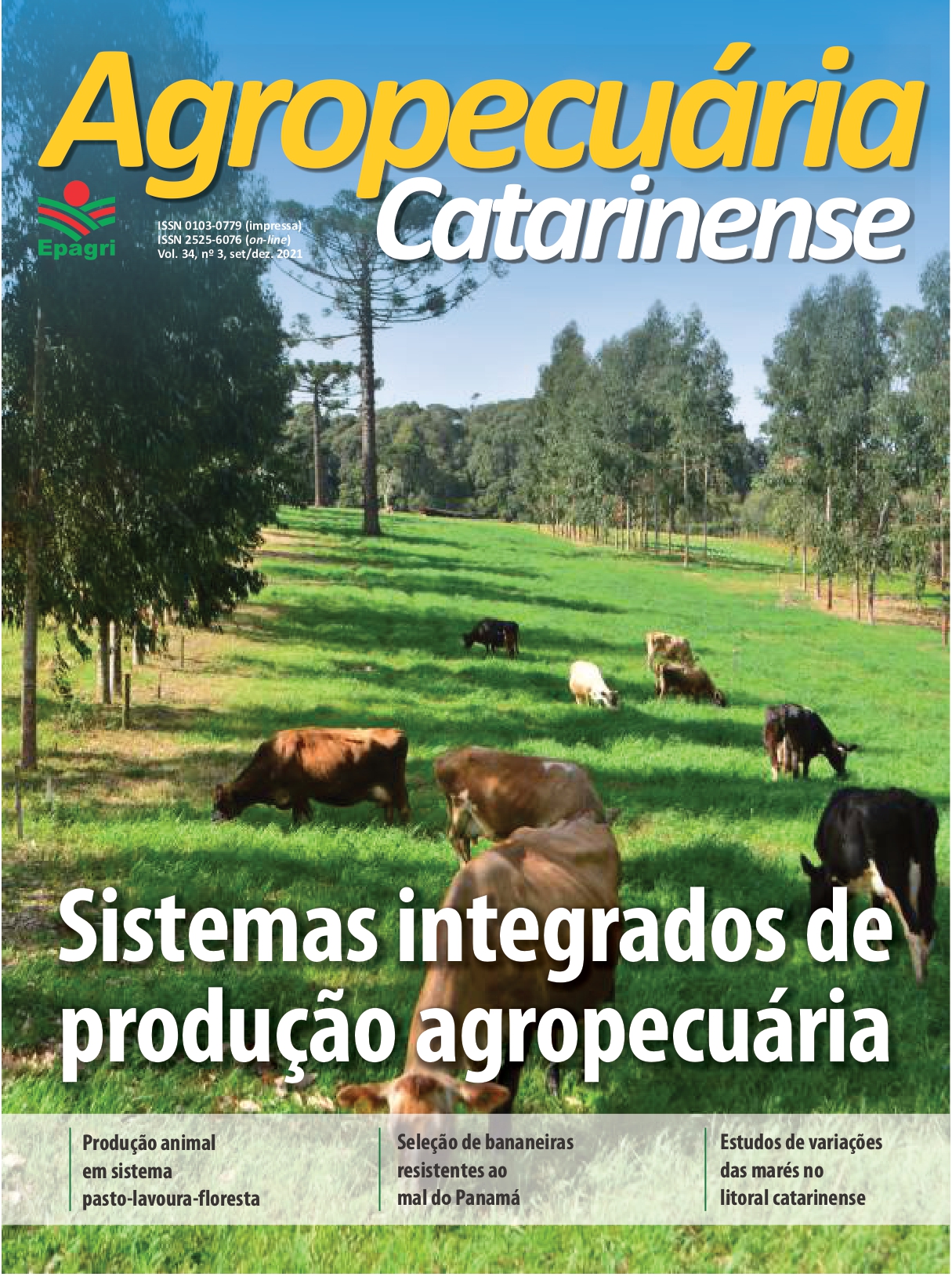Seleção de fontes de resistência à raça 4 tropical de Fusarium oxysporum f. sp. cubense em uma coleção de germoplasma de bananeira através de marcadores moleculares
DOI:
https://doi.org/10.52945/rac.v34i3.1105Palavras-chave:
Murcha de fusarium, Marcadores SCAR, Musa acuminata, Musa balbisianaResumo
A coleção de germoplasma de bananeira da Epagri, na Estação Experimental de Itajaí possui 120 acessos de diferentes origens, servindo os propósitos de conservação e melhoramento. Um dos maiores desafios do melhoramento genético de bananeira é a seleção de plantas resistentes ao Fusarium oxysporum f. sp. cubense. Este trabalho objetivou identificar, via marcadores moleculares, plantas resistentes a raça 4 tropical, atualmente ausente no Brasil. Os resultados mostraram uma ampla presença de marcas moleculares associadas à resistência da raça 4 tropical nos genótipos da coleção de germoplasma. Estas informações são importantes para o avanço do programa de melhoramento genético de bananeira da Epagri.
Métricas
Publication Facts
Reviewer profiles Indisp.
Author statements
- Academic society
- Epagri - Revista Agropecuária Catarinense
- Publisher
- Empresa de Pesquisa Agropecuária e Extensão Rural de Santa Catarina - Epagri
Referências
EPAGRI. Números da Agropecuária Catarinense. Florianópolis:EPAGRI, 2020. 64p. (Epagri. Documentos, 313).
GARCÍA-BASTIDAS, F.A.; QUINTERO-VARGAS, J.C.; AYALA-VASQUEZ, M.; SCHERMER, T.; SEIDL, M.F.; SANTOS-PAIVA, M.; NOGUERA, A.M.; AGUILERA-GALVEZ, C.; WITTENBERG, A.; HOFSTEDE, R.; SØRENSEN, A.; KEMA, G.H.J. First Report of Fusarium Wilt Tropical Race 4 in Cavendish Bananas Caused by Fusarium odoratissimum in Colombia. Plant Disease, Saint Paul, v.104, n.3, p.994-994, 2020. DOI: https://doi.org/10.1094/PDIS-09-19-1922-PDN.
D´HONT, A.; DENOEUD, F.; AURY, J-M.; BAURENS, F-C.; CARREEL, F.; GARSMEUR, O.; NOEL, B.; BOCS, S.; DROC, G.; ROUARD, M.; SILVA, C.; JABBARI, K.; CARDI, C.; POULAIN, J.; SOUQUET, M.; LABADIE, K.; JOURDA, C.; LANGELLÉ, J.; ROGIER-GOUD, M.; ALBERTI, A.; BERNARD, M.; CORREA, M.; AYYAMPALAYAM, S.; MCKAIN, M.R.; LEEBENS-MACK, J.; BURGESS, D.; FREELING, M.; MBÉGUIÉ-A-MBÉGUIÉ, D.; CHABANNES, M.; WICKER, T.; PANAUD, O.; BARBOSA, J.; HRIBOVA, E.; HESLOP-HARRISON, P.; HABAS, R.; RIVALLAN, R.; FRANCOIS, P.; POIRON, C.; KILIAN, A.; BURTHIA, D.; JENNY, C.; BAKRY, F.; BROWN, S.; GUIGNON, V.; KEMA, G.; DITA, M.; WAALWIJK, C.; JOSEPH, S.; DIEVART, A.; JAILLON, O.; LECLERCQ, J.; ARGOUT, X.; LYONS, E.; ALMEIDA, A.; JERIDI, M.; DOLEZEL, J.; ROUX, N.; RISTERUCCI, A-M.; WEISSENBACH, J.; RUIZ, M.; GLASZMANN, J-C.; QUÉTIER, F.; YAHIAOUI, N.; WINCKER, P. The banana (Musa acuminata) genome and the evolution of monocotyledonous plants. Nature, Basingstoke, v.488, p.213-2017, 2012. DOI: https://doi.org/10.1038/nature11241.
DOYLE, J.J.; DOYLE, J.L. Isolation of plant DNA from fresh tissue. Focus, [S.l.], v.12, p.13-15, 1990.
FU, Y.B. The vulnerability of plant genetic resources conserved ex situ. Crop Science, Hoboken, v.57, n.5, p.2314-2328, 2017. DOI: https://doi.org/10.2135/cropsci2017.01.0014.
LI, W.M.; DITA M.; WU W.; HU G.B.; XIE J.H.; GE X.J. Resistance sources to Fusarium oxysporum f. sp. cubense tropical race 4 in banana wild relatives. Plant Pathology, Oxford, v.6, n.5, p.1061-1067, 2015. DOI: https://doi.org/10.1111/ppa.12340.
MARIESCHI, M.; TORELLI, A.; BEGHÉ, D.; BRUNI, R. Authentication of Punica granatum L.: development of SCAR markers for the detection of 10 fruits potentially used in economically motivated adulteration. Food Chemistry, Amsterdam, v.202, p.438–444, 2016. DOI: https://doi.org/10.1016/j.foodchem.2016.02.011.
PLOETZ, R.C. Fusarium wilt of banana is caused by several pathogens referred to as Fusarium oxysporum f. sp. cubense. Phytopathology, Saint Paul, v.96, n.6, p.653-656, 2006. DOI: https://doi.org/10.1094/PHYTO-96-0653.
PLOETZ, R.C. Fusarium wilt of banana. Phytopathology, Saint Paul, v.105, n.12, p.1512-1521, 2015. DOI: https://doi.org/10.1094/PHYTO-04-15-0101-RVW.
ORDONEZ, N.; SEIDL, M.F.; WAALWIJK, C.; DRENTH, A.; KILIAN, A.; THOMMA, B.P.H.J.; PLOETZ, R.C.; KEMA, G.H.J. Worse Comes to Worst: Bananas and Panama Disease — When Plant and Pathogen Clones Meet. PloS Pathogens, San Francisco, v.11, n.11, e1005197, 2015. DOI: https://doi.org/10.1371/journal.ppat.1005197.
SENASA. Senasa confirma brote de Fusarium Raza 4 Tropical en Piura. Servicio Nacional de Sanidad Agraria del Perú, 2021. Disponível em: https://www.gob.pe/institucion/senasa/noticias/429832-senasa-confirma-brote-de-fusarium-raza-4-tropical-en-piura. Acesso em: 13 maio 2021.
SUTHERLAND, R; VILJOEN, A.; MYBURG, A.A.; VAN DEN BERG, N. Pathogenicity associated genes in Fusarium oxysporum f. sp. cubense race 4. South African Journal of Science, Pretoria, v.109, n.5/6, p.1-10, 2013. DOI: https://doi.org/10.1590/sajs.2013/20120023.
THANGAVELU, R.; LOGANATHAN, M.; ARTHEE, R.; PRABAKARAN, M. UMA, S. Fusarium wilt: a threat to banana cultivation and its management. CAB Reviews, Wallingford, v.15, n.4, p.1-24, 2020. DOI: https://doi.org/10.1079/PAVSNNR202015004.
VAN DEN HOUWE, I.; CHASE, R.; SARDOS, J.; RUAS, M.; KEMPENAERS, E.; GUIGNON, V.; MASSART, S.; CARPENTIER, S.; PANIS, B.; ROUARD, M.; ROUX, N. Safeguarding and using global banana diversity: a holistic approach. CABI Agriculture and Bioscience, Basingstoke, v.1, n.15, p.1-22, 2020. DOI: https://doi.org/10.1186/s43170-020-00015-6.
VIEIRA, M.L.C.; SANTINI, L.; DINIZ, A.L.; MUNHOZ, C.F. Microsatellite markers: what they mean and why they are so useful. Genetics and Molecular Biology, Ribeirão Preto, v.39, n.3, p.312-328, 2016. DOI: https://doi.org/10.1590/1678-4685-GMB-2016-0027.
WANG, W.; HU, Y.; SUN, D.; STAEHELIN, C.; XIN, D.; XIE, J. Identification and evaluation of two diagnostic markers linked to Fusarium wilt resistance (race 4) in banana (Musa spp.). Molecular Biology Reports, Basingstoke, v.39, p.451-459, 2012. DOI: https://doi.org/10.1007/s11033-011-0758-6.
Downloads
Publicado
Como Citar
Edição
Seção
Licença
Copyright (c) 2021 Gustavo Henrique Ferrero Klabunde, Adriana Pereira, André Boldrin Beltrame, Ramon Felipe Scherer

Este trabalho está licenciado sob uma licença Creative Commons Attribution 4.0 International License.





